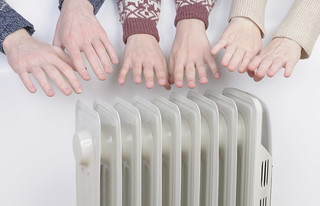I’ve recently become obsessed with saving money. Maybe it has to do with the fact that I’m poor, I work all the time, and my husband and I both still have a few years of grad school ahead of us. But here’s the thing, I know there’s got to be more ways for me to save. So this year, I made it my goal to learn more about saving money, in every way I possibly can.
 This month I turned my attention to saving on our heating bill. We live in a little house, but it’s pretty old and it gets drafty, so I knew there had to be some changes we could make. After taking to the internet, I decided to call a local company (shout out to the technician from Gunthers Heating and Air for the advice) and get some tips directly from the pros.
This month I turned my attention to saving on our heating bill. We live in a little house, but it’s pretty old and it gets drafty, so I knew there had to be some changes we could make. After taking to the internet, I decided to call a local company (shout out to the technician from Gunthers Heating and Air for the advice) and get some tips directly from the pros.
This article is about saving up to 20% on your heating bill, with a few minor changes. Now, I know what you’re thinking, the cold months are on their way out. But that doesn’t mean you can’t save. Plus, most of the changes offered here can be made at any time of the year. So plan ahead, and save yourself some money next year.
The Freebies
Some of these projects are free and easy, and some take a little planning and money. But first, let’s start with the free stuff:
Turn your thermostat down. This suggestion is the easiest, and makes up for the bulk of savings on your heating bill. For every degree you lower your thermometer, you should save about three percent on your heating bill. Meaning, if you lower your thermostat ten degrees every day when you leave for work, you’ll end up saving about 14% on your heating bill at the end of the month. (1) So stock up on blankets and warm socks, and keep your thermostat a little cooler than you usually do.
Raise the thresholds on your doors. If you can see the daylight coming through the bottom of your door, that means heated air can travel out. With many thresholds, you can simply loosen the screws on your thresholds to raise them. Just make sure you don’t make them so high the doors drag.
Keep your heating vents clean and clear. It stands to reason that heating vents that aren’t clear can’t do their jobs. Make sure there’s nothing in front of or covering your vents and make sure there’s nothing inside them.
Turn down your water heater. A difference of five degrees on your water heater is unnoticeable by humans, but it can save on your heating bill.
Use fans sparingly. In a short time, a kitchen or bathroom fan can empty your house of warm air. Use them only as you need them.
Keep windows, doors, and fireplaces closed up. This one seems self evident. Heat will escape if your doors and windows are left open. And the same goes for your fireplace. If you’re not using it, keep it closed or covered. Warm air will rise up right out of it if you don’t.
Those are some quick and easy ways to save a lot of money. And if you’re serious about cutting down, here are some options to consider that take a little more planning.

The Cheaper Options
Replace worn weatherstripping. Seven to twelve percent of your home’s heat is lost through improperly sealed windows and doors. Not only that, but cold air can come through worn weatherstripping, making for unpleasant cold drafts. (2) A container of caulk and a strip of weather stripping run in the range of $5-10.
Fill any open holes in exterior walls. If you have pipes, gas lines, or cable coming out of your house, buy a bottle of expanding foam (about $5) and fill them.
Fill in the space around your outlets. Outlets often aren’t insulated, so take off the cover plates, fill in the space with caulking or expanding foam, and place a foam gasket over the outlet or switch before you put the cover back on. Foam gaskets are about a dollar for a package of two. Going to extra mile to insulate your electrical boxes could eliminate a lot of holes in your walls where heated air is escaping.
The Pricier Options
Place plastic film on your windows. Windows account for about 25% of heat loss in a home. Just covering them with plastic film can save you up to 14% on your heating bill. (2)The film looks a lot like plastic wrap and can be purchased for about $20-30 for a 6×8 foot sheet. Simply apply it to your windows and take it off when the weather warms up.
Buy a space heater. A good space heater costs around $20-30 and costs 10-20 cents an hour to run. Still, if you turn down the heat in the rest of the house and turn on a space heater where you’ll be spending most your time, you’ll stay warm and you’ll save money.
Insulate your pipes and cover your water heater. If you’re water heater is in an unheated place (like a garage or a closet), buy it an insulated jacket ($20) to keep heat from escaping. Do the same with any water pipes that may run through uninsulated areas. Insulation only costs a few dollars per foot, so this is one of your least expensive options.
Insulate everywhere else. Well, not really. But go through your attic or any crawl spaces and look for opportunities to insulate. It could save you a lot.
Buy a chimney balloon. But only if you have a chimney. A chimney balloon is an inflatable balloon your stick up your chimney to keep hot air from escaping. While it costs about $50, it can save you $100 a year. (2)
Replace windows. Obviously you can’t do this step all at once, but as you have to replace windows and doors when they wear out, replace them with double-paned windows with low e-rating. While it might cost you $50-$100 more, it’ll save you a lot of money.
Keep your heater in shape. And, last but not least, keep your heater in shape. You could save yourself a lot in the long run by replacing an old heater with an energy-efficient one.
These bigger steps don’t have to be taken all at once, but you should have a plan to chip away at them. If you’re a renter, like me, you might not even have control over replacing your windows and doors. But you can ask your landlord to help with the costs of the smaller projects. For me and my husband, it was worth the little bit of money we had to put into our house to save a lot. We did all the free options (except for the chimney one, since we don’t have a chimney) replaced our weatherstripping and insulated excess holes, and we have already seen a difference in our heating bill. Plus, our house is a lot warmer.
1.http://realestate.msn.com/article.aspx?cp-documentid=13107978
2.http://www.popularmechanics.com/home/improvement/energy-efficient/9-sneaky-ways-to-cut-your-home-heating-bills#slide-1
 Mary Kremer loves, loves, loves writing and traveling. If she could do both forever, she’d be a happy camper. In her free time she hikes, tries to exercise, and bugs her husband about things like women’s issues as he’s trying to fall asleep.
Mary Kremer loves, loves, loves writing and traveling. If she could do both forever, she’d be a happy camper. In her free time she hikes, tries to exercise, and bugs her husband about things like women’s issues as he’s trying to fall asleep.


















